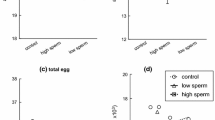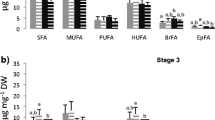Abstract
We investigated maternal body size and environmental effects on the oocyte size of the Atlantic sardine, Sardina pilchardus, a marine pelagophil, using a novel, oocyte stage-specific approach which takes into account the spawning lag. In particular, we focused on anatomical constraints imposed by the maternal body cavity to the growth of the ovary and its oocytes during the course of vitellogenesis (VIT) and oocyte maturation (OM). We analyzed variability in oocyte size in VIT and OM ovaries as a factor of maternal size, ambient temperature (SST) and preservation medium (formalin vs. ethanol) using the spawning lag of recent and imminent spawners, respectively, as a covariate. We showed that oocyte size correlates with maternal size in OM ovaries but not in VIT ovaries. More specifically, 10 cm difference in maternal body length corresponds to 0.112 mm2 (or 12 %) difference in the cross section of fully hydrated oocytes just previous to ovulation. On the other hand there was no inverse relationship between OM oocyte size at spawning and batch fecundity. Ambient SST was not an important determinant of hydrated oocyte size since the same 12 % difference in oocyte size was estimated for the entire SST range of the study. We suggest that these stage-specific differences in the effect of maternal size on oocyte size are due to a functional relationship between the abdominal volume and ovarian size.







Similar content being viewed by others
References
Baith K, Lindsay R, Fu G, McClain CR (2001) Data analysis system developed for ocean color satellite sensors. EOS Trans Am Geophys Union 82:202
Bernal M, Borchers D, Valdes L et al (2001) A new ageing method for eggs of fish species with daily spawning synchronicity. Can J Fish Aquat Sci 58:2330–2340
Blaxter J, Hunter JR (1982) The biology of the clupeoid fishes. Adv Mar Biol 20:1–123
Casey KS, Brandon TB, Cornillon P, Evans R (2010) The past, present, and future of the AVHRR pathfinder SST program. Oceanography from space. Springer, Dordrecht, pp 273–287
Castro LR, Claramunt G, Krautz MC et al (2009) Egg trait variation in anchoveta Engraulis ringens: a maternal response to changing environmental conditions in contrasting spawning habitats. Mar Ecol Prog Ser 381:237–248. doi:10.3354/Meps07922
Cerdà J, Fabra M, Raldúa D (2007) Physiological and molecular basis of fish oocyte hydration. In: Babin PJ, Cerdà J, Lubzens E (eds) The fish oocyte: from basic studies to biotechnological applications. Springer, Dordrecht, pp 349–396
Chambers RC (1997) Environmental influences on egg and propagule sizes in marine fishes. In: Chambers RC, Trippel EA (eds) Early life history and recruitment in fish populations. Chapman & Hall, London, pp 63–102
Claramunt G, Herrera G (1994) A new method to estimate the fraction of daily spawning females and the numbers of spawning in Sardinops sagax in northern Chile. Sci Mar 58:169–177
Claramunt G, Herrera G, Pizarro P (1994) Potential annual production of eggs according to sizes of Sardinops sagax in northern Chile. Rev Biol Mar Valpso 29:147–166
Coombs SH, Boyra G, Rueda LD et al (2004) Buoyancy measurements and vertical distribution of eggs of sardine (Sardina pilchardus) and anchovy (Engraulis encrasicolus). Mar Biol 145:959–970. doi:10.1007/s00227-004-1389-4
Daoulas C, Economou A (1986) Seasonal variation of egg size in the sardine, Sardina pilchardus Walb., of the Saronikos Gulf: causes and probable explanation. J Fish Biol 28:449–457
Duarte CM, Alcaraz M (1989) To produce many small or few large eggs: a size-independent reproductive tactic of fish. Oecologia 80:401–404
Fulton TW (1898) On the growth and maturation of the ovarian eggs of teleostean fishes. 16th annual report of the Fishery Board for Scotland, part 3, pp 83–134
Ganias K (2003) Oceanographic and biological study of sardine Sardina pilchardus (Walb., 1792) ichthyoplankton production in coastal waters of central Greece. University of Thessaly
Ganias K (2009) Linking sardine spawning dynamics to environmental variability. Estuar Coast Shelf Sci 84:402–408. doi:10.1016/j.ecss.2009.07.004
Ganias K, Somarakis S, Machias A, Theodorou A (2004) Pattern of oocyte development and batch fecundity in the Mediterranean sardine. Fish Res 67:13–23. doi:10.1016/j.fishres.2003.08.008
Ganias K, Nunes C, Stratoudakis Y (2007) Degeneration of sardine (Sardina pilchardus) postovulatory follicles: structural changes and factors affecting resorption. Fish Bull 105:131–139
Ganias K, Rakka M, Vavalidis T, Nunes C (2010) Measuring batch fecundity using automated particle counting. Fish Res 106:570–574. doi:10.1016/j.fishres.2010.09.016
Ganias K, Nunes C, Rakka M et al (2011) Estimating oocyte growth rate and its potential relationship to spawning frequency in teleosts with indeterminate fecundity. Mar Costal Fish 3:119–126. doi:10.1080/19425120.2011.555729
Ganias K, Murua H, Claramunt G et al (2014) Egg production. In: Dominguez-Petit R, Murua H, Saborido-Rey F, Trippel EA (eds) Handbook of applied fisheries reproductive biology for stock assessment and management. Digital CSIC, Madrid, p 110
Garrido S, Rosa R, Ben-Hamadou R et al (2007) Effect of maternal fat reserves on the fatty acid composition of sardine (Sardina pilchardus) oocytes. Comp Biochem Physiol 148:398–409. doi:10.1016/j.cbpb.2007.07.008
Green BS (2008) Maternal effects in fish populations. Adv Mar Biol 54:1–105
Guisande C, Riveiro I, Sola A, Valdes L (1998) Effect of biotic and abiotic factors on the biochemical composition of wild eggs and larvae of several fish species. Mar Ecol Prog Ser 163:53–61. doi:10.3354/Meps163053
Jons D, Miranda E (1997) Ovarian weight as an index of fecundity, maturity, and spawning periodicity. J Fish Biol 50:150–156
Jung K-M, Folkvord A, Kjesbu OS, Sundby S (2014) Experimental parameterisation of principal physics in buoyancy variations of marine teleost eggs. PLoS ONE 9:e104089. doi:10.1371/journal.pone.0104089
Kamler E (2005) Parent–egg–progeny relationships in teleost fishes: an energetic perspective. Rev Fish Biol Fish 15:399–421
Kilpatrick KA, Podesta GP, Evans R (2001) Overview of the NOAA/NASA advanced very high resolution radiometer Pathfinder algorithm for sea surface temperature and associated matchup database. J Geophys Res 106:9179–9197
Kjesbu OS (1989) The spawning activity of cod, Gadus morhua. J Fish Biol 34:195–206
Leal EM, Castro LR, Claramunt G (2009) Variability in oocyte size and batch fecundity in anchoveta (Engraulis ringens, Jenyns 1842) from two spawning areas off the Chilean coast. Sci Mar 73:59–66. doi:10.3989/scimar.2009.73n1059
Matsuoka M, Konishi Y (1996) Morphological characteristics of unfertilized eggs of the Japanese sardine, compared with fertilized ones. Fish Sci 62:855–859
Morimoto H, Watanabe Y, Yamashita Y, Oozeki Y (1994) Effects of maternal nutritional conditions on number, size and lipid content of hydrated eggs in the Japanese sardine from Tosa Bay, southwestern Japan. International workshop: survival strategies in early life stages of marine resources, Yokohama, Japan, 11–14 Oct 1994
Pebesma EJ (2004) Multivariable geostatistics in S: the gstat package. Comput Geosci 30:683–691
R Development Core Team (2013) R: A language and environment for statistical computing. R Foundation for Statistical Computing, Vienna, Austria. http://www.R-project.org/
Rakka M, Ganias K (2015) Assessing species and stage specific effects of preservation on fish ovarian material over different temporal scales. Mediterr Mar Sci. doi:10.12681/mms.1205
Ré P (1981) Seasonal occurrence, mortality and dimensions of sardine eggs Sardina pilchardus (Walbaum) off Portugal. Cybium 5:41–48
Riveiro I, Guisande C, Lloves M et al (2000) Importance of parental effects on larval survival in Sardina pilchardus. Mar Ecol Prog Ser 205:249–258
Somarakis S, Ganias K, Tserpes G, Koutsikopoulos C (2004) On gonadal allometry and the use of the gonosomatic index: a case study in the Mediterranean sardine, Sardina pilchardus. Mar Biol 146:181–189
Stratoudakis Y, Coombs S, de Lanzos AL et al (2007) Sardine (Sardina pilchardus) spawning seasonality in European waters of the northeast Atlantic. Mar Biol 152:201–212
Thorsen A, Fyhn HJ (1996) Final oocyte maturation in vivo and in vitro in marine fishes with pelagic eggs; yolk protein hydrolysis and free amino acid content. J Fish Biol 48:1195–1209
Trippel EA, Neil SRE (2004) Maternal and seasonal differences in egg sizes and spawning activity of northwest Atlantic haddock (Melanogrammus aeglefinus) in relation to body size and condition. Can J Fish Aquat Sci 61:2097–2110
Tsuruta Y, Hirose K (1989) Internal regulation of reproduction in the Japanese anchovy (Engraulis japonica) as related to population fluctuation. Can Spec Publ Fish Aquat Sci 108:111–119
Valdes Szeinfeld E (1991) Cannibalism and intraguild predation in clupeoids. Mar Ecol Prog Ser 79:17–26
Zwolinski J, Mason E, Oliveira PB, Stratoudakis Y (2006) Fine-scale distribution of sardine (Sardina pilchardus) eggs and adults during a spawning event. J Sea Res 56:294–304
Acknowledgments
This work was supported by the National Biological Sampling Programme (PNAB/EU DCF) for DEPM surveys funded by the European Union. Thanks are due to Dr. M.M. Angelico for helpful recommendations. Particular thanks are due to all IPMA staff that contributed to the collection of DEPM samples and the histological preparations. The work of M. Rakka, T. Vavalidis and E. Mantzouki was partly done within the framework of a collaboration between the School of Biology of AUTH and IPMA under the ERASMUS PLACEMENT PROGRAMME.
Author information
Authors and Affiliations
Corresponding author
Ethics declarations
Conflict of interest
We have no conflicts of interest to disclose.
Research involving human participants and/or animals
The present study did not involve any human participants and or animals.
Informed consent
We did not conduct any healthcare interventions to human participants.
Additional information
Communicated by M. Peck.
Reviewed by undisclosed experts.
Rights and permissions
About this article
Cite this article
Ganias, K., Rakka, M., Mantzouki, E. et al. Maternal versus environmental constraints on the oocyte size of a marine pelagophil fish. Mar Biol 162, 1879–1888 (2015). https://doi.org/10.1007/s00227-015-2719-4
Received:
Accepted:
Published:
Issue Date:
DOI: https://doi.org/10.1007/s00227-015-2719-4




